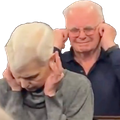

Oh, okay, I think I misinterpreted what you said before, but rereading it now I understand.


Oh, okay, I think I misinterpreted what you said before, but rereading it now I understand.


This is somewhat misleading. Here’s a section from near the beginning of a scientific review I linked in my reply to @ChuckEffingNorris@lemmy.ml:
To reduce spread of respiratory diseases, we need to understand the mechanisms of spread. There is strong and consistent evidence that respiratory pathogens including severe acute respiratory syndrome coronavirus 2 (SARS-CoV-2), respiratory syncytial virus (RSV), influenza, tuberculosis, and other coronaviruses such as MERS and SARS-1, are transmitted predominantly via aerosols. Infected individuals, whether symptomatic or not, continuously shed particles containing pathogens, which remain viable for several hours and can travel long distances. [Emphasis mine.] SARS-CoV-2 is shed mainly from deep in the lungs, not the upper respiratory tract, and the viral load is higher in small aerosols (generated in the lower airways) than in larger droplets (generated in upper airways). Whereas large respiratory droplets emitted when people cough or sneeze fall quickly by force of gravity without much evaporation, those below 100 µm in diameter become (bio)aerosols. Even particles tens of microns in diameter at release will shrink almost immediately by evaporation to the point that under typical conditions they can remain airborne for many minutes. In contrast with droplet transmission, which is generally assumed to occur via a single ballistic hit, the risk of airborne transmission increases incrementally with the amount of time the lung lining is exposed to pathogen-laden air, in other words, with time spent indoors inhaling contaminated air.
Respiratory infections may theoretically also be transmitted by droplets, by direct contact, and possibly by fomites (objects that have been contaminated by droplets), but the dominant route is via respiratory aerosols. The multiple streams of evidence to support this claim for SARS-CoV-2 include the patterning of spread (mostly indoors and especially during mass indoor activities involving singing, shouting, or heavy breathing), direct isolation of viable virus from the air and in air ducts in ventilation systems, transmission between cages of animals connected by air ducts, the high rate of asymptomatic transmission (i.e., passing on the virus when not coughing or sneezing), and transmission in quarantine hotels when individuals in different rooms shared corridor air but did not meet or touch any common surface.


Masks and respirators for prevention of respiratory infections: a state of the science review
I recommend giving this a read when you have the time, it should hopefully answer any questions you have and better than I can.
An assumed droplet and contact mode of transmission leads to prevention policies that center on handwashing and surface cleansing, maintaining 2-m physical distancing, wearing medical masks (whose waterproof backing is designed to stop droplets) within that 2-m distance (especially when attending an infected patient), using physical barriers (e.g., plastic screens) and providing health-care workers with higher-grade respiratory protection only when undertaking AGMPs. However, if the virus is transmitted significantly by the airborne route, different prevention policies are needed, oriented to controlling air quality in indoor spaces (e.g., ventilation and filtration), reducing indoor crowding and time spent indoors, wearing masks whenever indoors, careful attention to mask quality (to maximize filtration) and fit (to avoid air passing through gaps), taking particular care during indoor activities that generate aerosols (e.g., speaking, singing, coughing, and exercising), and providing respirator-grade facial protection to all staff who work directly with patients (not just those doing AGMPs)
This is why I specified N95 respirators in my first comment. If you are unfamiliar, N95 is a NIOSH air filtration rating, which is used to describe the ability of a respirator to protect the wearer from airborne solid and liquid particulates. The review I linked goes into more details on this as well. I recommended N95 or better specifically because Covid is the illness I’m most concerned with avoiding, and the evidence suggests that they provide meaningful protection over lower grade respirators or surgical masks. Another quote from the link above that stood out to me:
The certification of surgical masks for particle/bacterial filtering efficiency (P/BFE) does not reflect equivalence to respirators as the filtration is typically compromised by poor face seal. The ASTM F2100-21 P/BFE certification, for example, requires at least 95% filtration against 0.1-µm particles and at least 98% against aerosolized Staphylococcus aureus, but this is on a sample of the mask clamped in a fixture, not on a representative face. In terms of filtering aerosols, N95 respirators outperform surgical masks between 8- and 12-fold. The effectiveness of certified surgical mask material against transmission when used as a filter was demonstrated in a hamster SARS-CoV-2 model. Infected hamsters were separated from non-infected ones by a partition made of surgical mask material; when the partition was in place, transmission of SARS-CoV-2 was reduced by 75%.
In addition to protecting the wearer, respirators provide very effective source control by dramatically limiting the amount of respiratory aerosols emitted by infectious individuals. In one study, risk of infection was reduced approximately 74-fold when infected, and susceptible individuals both wore well-fitting FFP respirators compared to when both wore surgical masks.
As for one-way masking, well, it is unfortunately significantly less effective (from what I understand), and is a big part of why I’m so concerned by others not masking. I simply cannot avoid being around others all the time, and their lack of effort is directly endangering me and my wife. If it really all came down to personal choice, I wouldn’t care if people wanted to risk their health. Still, while I don’t have any studies or anything to link you at the moment specifically on the effectiveness of one-way masking, all I know is that I mask and don’t get sick, and they don’t mask and do get sick. It’s anecdotal, sure, and I’m certain the mask is not the only thing affecting this, but as far as I can see it’s the largest difference in our behavior. I’ve heard as well that wearing a respirator will reduce viral load should you be infected despite the filter, and so your sickness will be less severe, but I don’t have any evidence on hand for this.


I would like everyone to wear them until the pandemic is over, at least. After that we can reassess the situation, and preferably during flu season. To me it seems cruel to not mask for that seeing as it would greatly reduce the number of preventable flu deaths.
I think if all, or more realistically enough, of us were masking, that would eliminate the social stigma surrounding it. Personally, I don’t receive much pushback about my mask aside from the occasional staring anyways. What’s far more ostracizing to her, I, and several other people I know, is the fact that all of the social gatherings and hobbies we used to participate in are no longer accessible to us because not a single one is taking any acceptable precautions. In fact, I can think of exactly two social events I wanted to participate in this year that still “required” masks, and neither actually enforced the rule. This is sadly not a new problem for disabled people either. Many, if not most, are alienated from society and forced away from any participation in social activities due to a blatant disregard towards making those activities actually accessible to them. I cannot stress enough how painful this is for those people on the receiving end of this ableism. So, frankly, I have little sympathy for those who fear ostracism from choosing to wear a mask. If they really care about people being ostracized, they should do what they can to make their social circles safe for everyone, not just those without disabilities.


We’d rather not take risks. Plus, we’d like to not accidentally contribute to the spread of disease ourselves if we can help it.


I do not have kids, and I don’t know about all of my coworkers, but I know the overwhelming majority of them do not have kids either.


Key word being occasionally, and also not with a disease that causes serious health complications, cognitive decline, and that itself damages your immune system.
COVID linked to 65% of new onset cognitive impairment, dementia
Every COVID Infection Increases Your Risk of Long COVID, Study Warns
SARS-CoV-2 infection weakens immune-cell response to vaccination
Yes, Everyone Really Is Sick a Lot More Often After Covid
Cognitive performance of post-covid patients in mild, moderate, and severe clinical situations


Mask. N95 or better. My wife and I never stopped, and she never gets sick despite being immunocompromised. I work in a place where illness is common due to the environment and I’ve been sick once in the last year, meanwhile all of my coworkers come in sick like twice a month. Apparently they’d rather be sick and miserable all the time than wear a mildly uncomfortable thing on their face.


Nah, not yet at least, I’m just borrowing a Hexbear emoji. If you view the source on a comment using a non-unicode emoji, you can see that it’s actually just an embedded image, which you can then copy and paste to use in comments from any instance. It’s a little unwieldy, but if you know the name of the emoji you want to use it’s usually pretty easy to find what you are looking for.


By “neat and easy” I mean, “The root of all evil is capitalism and we solve that with revolution”.
This is exactly why they are responding to you as they are. This is not an accurate summary of the marxist position. You’ve built up a strawman to knock down to justify calling us cultish.
Some basic questions that marxists are concerned with:
Why is a revolution necessary to begin with?
Who is exploited, and who is the exploiter?
What material conditions are necessary for a revolution to be possible?
How do you organize society post-revolution?
How do you prevent those who oppose the liberation of the proletariat from taking over your post-revolutionary society and destroying it?
How do we learn from the successes and the failures of history so that we don’t repeat the same mistakes?
If you don’t understand the marxist position on these questions, yet continue to criticize us, then of course you will come to nonsense conclusions and just piss people off. You’ve made up a guy to represent us and then mock them.


So when people constantly call us deluded, cult followers, bots, shills, brainwashed, fascists, bigots, trump supporters, and any other number of dehumanizing insults, often coming into our spaces to do so, all the while themselves defending some of the most violent and evil people in history in the name of “lesser evil”, are we supposed to just turn the other cheek and never respond in kind? When we witness the regular defense of the people ensuring the destruction of Palestine continues, are we supposed to just patiently and calmly explain how genocide is bad, actually? When dot worlders accuse me of faking being trans and being a privileged child, am I not justified in losing my temper? Y’all do not even try to understand where we are coming from, constantly use strawman arguments and put words in our mouths, but we’re supposed to smile politely while you spit in our faces? Like this is literally a thread spawning from an OP that is just an ableist insult, and yet some of us are still in here trying to talk things out despite that!
And it’s not like it’s limited to Lemmy, right? Literally everywhere I go I have to either tolerate anti-communist red scare bullshit, transphobia, ableism, misogyny, etc., or I have to try and have stressful and exhausting conversations with people who never, ever take me seriously. So yeah, we’re kind of on edge! If you get shit on for that when it wasn’t deserved, then I’m genuinely sorry, and I wish it wasn’t something that happens. But can you at the least understand that it is not a one-way street here?


I wonder what that something is? 


I highly recommend you give Blackshirts and Reds: Rational Fascism and the Overthrow of Communism and On Authority a read. At least On Authority, as it’s a very short piece, but the two combined should give you a basic understanding of the historical and theoretical basis of why marxists defend the use of authority. I can understand where you are coming from, I was more than a little skeptical of authoritarianism when I was younger and still identified as an anarchist, but I think if you take the time to honestly engage with our position then you will at least understand why our stance is what it is, and how we are diametrically opposed to fascism, even if you don’t agree with us.


That’s right folks, remember not to engage with any opposing ideology in an honest or intellectually rigorous manner! If someone is critical of your beliefs, it is important to simply ignore them and never seriously consider either of your positions. 

Within the confines of the law, your best chance at pressuring Harris to change her position is to very vocally demand the Democrats cease support of Israel immediately, and that if they don’t then you will not support or vote for them. What other leverage do you have over them?


Harris is sitting here telling you that she will not stop funding/supplying the genocide of Palestinians, that she will take a stricter border policy and continue building the wall, that under her the US military will be the most lethal fighting force. Not to mention her horrific track record up to this point. A vote for Harris is just as much a vote for fascism as a vote for Trump is. Not that voting out fascism in the USA was ever a realistic option to begin with.


yeah yeah yeah just plug your ears and close your eyes. erase my identity because i don’t conform to your narrow minded worldview. i’ll give you one thing, you’re damn right i’m hateful. i’ve spent my whole life in the west and hated every miserable minute of it. keep defending my oppressors all you like though, i’m sure the colonial murder machine will pay you back graciously one day


not paid, just an american trans woman who’s tired of suffering in this piece of shit country, and sick to death of chauvinistic pigs like you.
stay at hexbeer please.
no. i’ll say whatever i want to scum bags like you. deal with it.
It’s always reassuring to hear more evidence, anecdotal or otherwise, that the N95s work. There’s definitely still at least some risk though, my roommate is currently recovering from Covid themselves despite not going out often and always masking when they do. I believe it’s the only time they’ve been infected, so the masks have made a difference for sure, but still. We’ve thankfully been able to isolate and avoid giving it to each other at least.
Our behavior is still pretty limited by others behavior though, too. For instance, I can’t go drinking or out to eat with friends because I won’t take my mask off. At work it can be very difficult for me to even eat lunch safely because of this. Swimming is another thing, or concerts, I used to like going to punk and metal shows, but with how rowdy they are and how much close contact and heavy breathing there is, it’s just far too risky even with my mask on. Lots of things like these add up. I also feel it’s really unfair to those who are unable to mask, like for instance there’s a lot of homeless people in my city who definitely cannot remain masked all the time or even close, shouldn’t we be taking precautions to protect them, or people like them who can’t protect themselves?